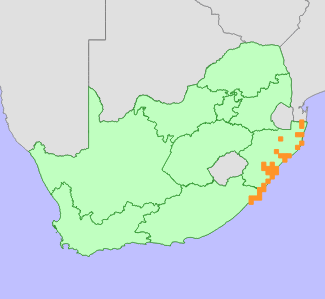|
Scientific Name | Cassipourea gummiflua Tul. var. verticillata (N.E.Br.) J.Lewis |
Higher Classification | Dicotyledons |
Family | RHIZOPHORACEAE |
Synonyms | Cassipourea verticillata N.E.Br. |
Common Names | Large-leaved Onionwood (e) |
National Status |
Status and Criteria | Vulnerable* A4acd |
Assessment Date | 2008/01/15 |
Assessor(s) | V.L. Williams, D. Raimondo, N.R. Crouch, A.B. Cunningham, C.R. Scott-Shaw, M. Lötter & A.M. Ngwenya |
Justification | A reduction in the national population of at least 50% is suspected to be reached within the next 50 years due to habitat loss as a result of deforestation and this species' popularity in the medicinal trade (generation length 50 years). The national status is downgraded by one category following IUCN regional assessment procedures, as the South African population is continuous with Mozambique. |
Distribution |
Endemism | Not endemic to South Africa |
Provincial distribution | Eastern Cape, KwaZulu-Natal |
Range | Port St Johns to KwaZulu-Natal and through Mozambique to Tanzania and Mascarene islands. |
Habitat and Ecology |
Major system | Terrestrial |
Major habitats | Sand Forest, Northern Coastal Forest, Scarp Forest, Southern Mistbelt Forest, Swamp Forest, Lowveld Riverine Forest |
Description | Evergreen forest, riverine and swamp forest. Moist scarp forest and coastal lowland forest. |
Threats |
| Bark is harvested for traditional medicine and sold in the medicinal plant markets in KwaZulu-Natal, Gauteng and Mpumalanga. In Mpumalanga, Botha et al. (2001) report that Cassipourea spp. is in high demand. Williams (2007) reported that 60% of muthi shops in 1994 and 2% of street traders in the Faraday market sold Cassipourea spp. The species is more popular in the muthi trade than published records would seem to indicate (A.B. Cunningham, pers. comm., 2008).
Various participants at the Medicinal Plant Red List Workshop (14-15/01/2008, SANBI, Durban) had witnessed trees dying due to ring-barking, whole subpopulations that had been harvested, and a decline in the species' abundance. Dead trees were noted in the coastal areas, e.g. Noodsberg and Maqumbi forests, where ring-barking and subsequent mortality had occurred (R. Scott-Shaw, pers. comm., 2008). Participants were also of the opinion that its AOO had probably declined at least 20-30% because of deforestation and land transformation of the moist scarp and coastal lowland forests in the past. Furthermore, while the species is relatively fast growing, the available habitat is expected to degrade/decline at least 30% in the next 50 years. |
Population |
Population trend | Decreasing |
Assessment History |
Taxon assessed |
Status and Criteria |
Citation/Red List version | | Cassipourea gummiflua Tul. var. verticillata (N.E.Br.) J.Lewis | VU A4acd | Raimondo et al. (2009) | |
Bibliography |
Botha, J., Witkowski, E.T.F. and Shackleton, C.M. 2001. An inventory of medicinal plants traded on the western boundary of the Kruger National Park, South Africa. Koede 44(2):7-46.
Pooley, E. 1998. The complete field guide to trees of Natal, Zululand and Transkei. Natal Flora Publications Trust, Durban.
Raimondo, D., von Staden, L., Foden, W., Victor, J.E., Helme, N.A., Turner, R.C., Kamundi, D.A. and Manyama, P.A. 2009. Red List of South African Plants. Strelitzia 25. South African National Biodiversity Institute, Pretoria.
Torre, A.R. and Goncalves, A.E. 1978. Rhizophoraceae. In: E. Launert (ed). Flora Zambesiaca 4:81-99. Flora Zambesiaca Managing Committee, London.
Williams, V.L. 2007. The design of a risk assessment model to determine the impact of the herbal medicine trade on the Witwatersrand on resources of indigenous plant species. Unpublished PhD Thesis, University of the Witwatersrand, Johannesburg.
|
Citation |
| Williams, V.L., Raimondo, D., Crouch, N.R., Cunningham, A.B., Scott-Shaw, C.R., Lötter, M. & Ngwenya, A.M. 2008. Cassipourea gummiflua Tul. var. verticillata (N.E.Br.) J.Lewis. National Assessment: Red List of South African Plants version . Accessed on 2025/05/31 |
 Comment on this assessment
Comment on this assessment

